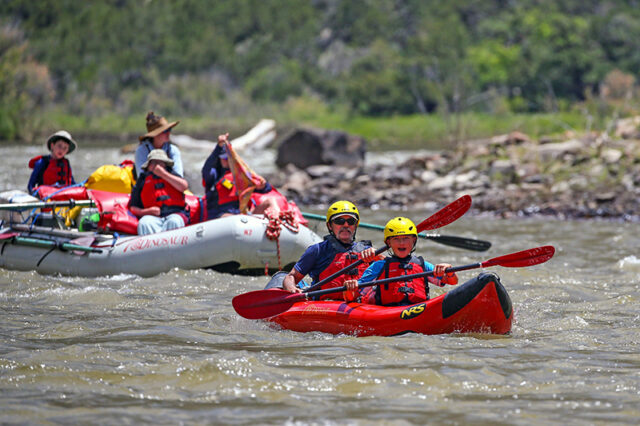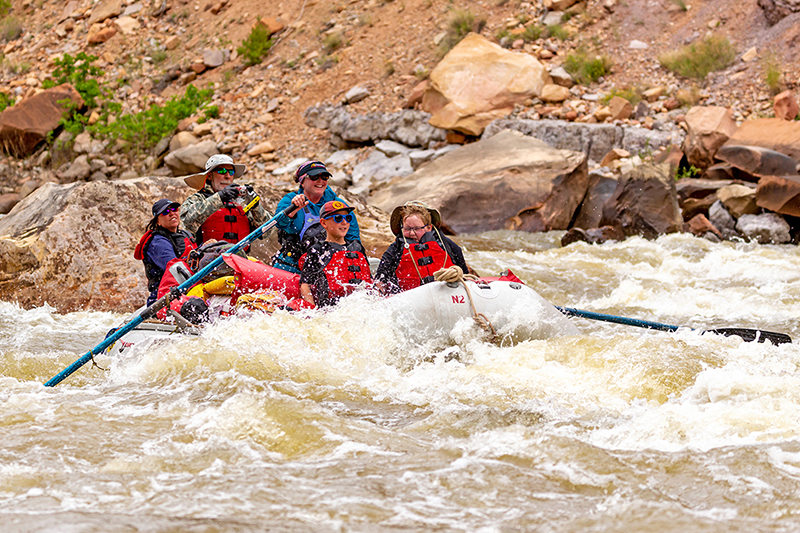If you’re planning a rafting trip, knowing about river classifications is important. These ratings help you understand what to expect on the water and how to prepare. Let’s look at the International Scale of River Difficulty and some examples from Utah’s Green and Yampa Rivers.
Key Takeaways
| Aspect | Details |
| Classification Range | Class I (Easy) to Class VI (Extreme) |
| Beginner-Friendly | Class I and II rapids |
| Intermediate | Class III rapids |
| Advanced | Class IV and V rapids |
Class 1 rapids on the Green River in Utah
The Basics of River Classifications
The International Scale of River Difficulty ranges from Class I (easy) to Class VI (extreme). This system helps rafters, kayakers, and river guides assess the challenges they might face on a particular stretch of water. The Green River in Utah is a great place to experience different classifications firsthand.
Here’s a quick rundown of what each class means:
| Class | Difficulty | Description | Example | Status |
| I | Easy | Smooth water with few obstacles | Green River – Flaming Gorge | Beginner |
| II | Novice | Simple rapids with clear channels | Green Riiver – Flaming Gorge | Beginner |
| III | Intermediate | Rapids with moderate waves and obstacles | Yampa River | Skilled |
| IV | Advanced | Intense rapids requiring precise maneuvering | Yampa & Gates of Lodore | Expert |
| V | Expert | Extremely difficult rapids with high risks | – | Pro |
| VI | Extreme | Often unrunnable, only for experts | – | Elite |
Class I and II: Perfect for Beginners

Class I and II rivers are great for first-timers and families. The water is mostly calm, with small waves and easy-to-spot obstacles. On the Green River, you’ll find stretches like this in Labyrinth Canyon or on our Flaming Gorge daily rafting trip. It’s a good place to learn basic paddling skills and get comfortable on the water.
Class II rapids might have some small drops or rocks to navigate around, but they’re still pretty straightforward. These sections are fun without being too scary, making them ideal for novice rafters. The gentle flow allows beginners to practice reading the river and understanding basic water dynamics.
On these easier sections, you’ll have time to take in the scenery and wildlife along the riverbanks. It’s a perfect opportunity to learn about river ecology and the importance of water conservation. Many guided trips on Class I and II sections include educational components about the local environment.
Class III: Stepping Up the Excitement

Class III rapids kick things up a notch. You’ll see bigger waves, stronger currents, and more obstacles to dodge. The Green River’s Split Mountain Canyon has some great Class III rapids that’ll get your heart pumping.
These rapids need teamwork and good paddling skills. You might hit some waves that splash into the raft, but that’s part of the fun! The Utah and Colorado 5 offer plenty of Class III thrills.
Class III rapids often feature technical maneuvers around rocks or through narrow passages. This is where you’ll start to appreciate the importance of reading the river and anticipating obstacles. Guides will often provide more detailed instructions on how to approach each rapid, helping you understand the strategy behind navigating whitewater.
Class IV: Advanced Whitewater Action
Now we’re talking serious whitewater! Class IV rapids are intense, with powerful waves, drops, and tricky currents. You need to be in good shape and have solid rafting experience for these.
The Yampa River in Utah has some awesome Class IV rapids, especially in Warm Springs. These rapids demand quick thinking and strong paddling skills. It’s a rush, but safety is super important here.
Class IV rapids often require precise boat positioning and coordinated team efforts. You might encounter features like hydraulics, large waves, and steep drops. These sections of river test your physical abilities, mental focus, and decision-making skills under pressure. Join us on our guided Yampa rafting trip in Dinosaur National Monument.
Class V and VI: Expert Territory
Class V rapids are for experts only. They’re extremely difficult and dangerous, with big drops, huge waves, and complex maneuvering. You need top-notch skills and experience to tackle these safely.
Class VI? That’s the limit of what’s possible in a raft or kayak. These rapids are often considered too risky to run. You won’t find many of these on commercial trips because they’re just too dangerous.
Class V and VI rapids require extensive scouting before attempting. Rafters and kayakers at this level need to be prepared for potential rescue situations and deeply understand river hydraulics. These sections often involve long, continuous rapids with little opportunity for rest or recovery.
Choosing Your Adventure
When picking a river trip, match the classification to your skill level and comfort zone. If you’re new to rafting, start with Class I or II. As you gain experience, you can work your way up to more challenging waters.
The best rivers for rafting offer a mix of classifications, letting you enjoy calm stretches and exciting rapids in one trip. This variety keeps the experience interesting and allows you to progressively challenge yourself as you build confidence.
Consider factors like the length of the trip, the season, and water levels when choosing your adventure. Spring runoff can increase difficulty levels, while late summer might see easier conditions on some rivers. Always check with local outfitters for the most up-to-date information on river conditions.
Safety First: Be Prepared
No matter the river classification, safety should always be your top priority. Here are some key points to remember:
Safety First: Be Prepared
- Always wear a life jacket
- Listen to your guide’s instructions
- Know your limits and don’t push them
- Be aware of changing water levels and weather
- Bring appropriate gear for the conditions
Guided rafting trips are a great way to experience different river classifications safely. Professional guides know the river well and can help you navigate challenging sections.
It’s crucial to understand and follow river etiquette and Leave No Trace principles. This includes respecting wildlife, properly disposing of waste, and being courteous to other river users. Many rivers flow through sensitive ecosystems, and it’s our responsibility to preserve these natural environments for future generations.
Ready to Hit the Rapids?

The Green and Yampa Rivers in Utah offer a fantastic range of experiences for all skill levels. From peaceful Class I sections to thrilling Class IV rapids, these rivers showcase the diversity of whitewater rafting. Each classification provides a unique perspective on the river environment and challenges you in different ways.
Remember, river conditions can change based on water levels and weather, so always check current conditions before your trip. With the right preparation and respect for the river, you’re set for an unforgettable rafting experience.
Ready to plan your next river adventure? Explore your rafting options and find the perfect trip for your skill level and interests. The rivers are waiting for you!
Whether you want a peaceful float through scenic canyons or an exciting journey through challenging rapids, river rafting has something for everyone. By understanding river classifications, you can choose an adventure that matches your skills and interests, ensuring a safe and fun experience on the water. So grab your paddle, put on your life jacket, and get ready to make great memories on some of Utah’s most beautiful rivers!



